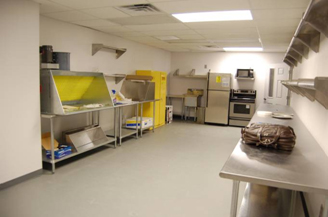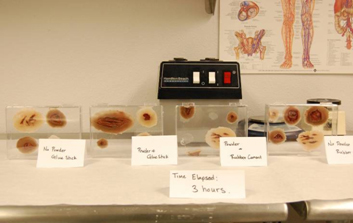

VRMC’s downtown Orlando, FL research and development laboratory
The Virtual Reality Medical Center Orlando
Laboratory
The Virtual Reality Medical Center (VRMC) downtown Orlando, Florida office is a 2,000 square foot research, development, and manufacturing facility centrally located in the Parramore district. A second office located within the 70,000 square foot laboratory space at the University of Central Florida (UCF) Institute for Simulation and Training (IST) in Central Florida’s Research Park is fostering collaboration between these partners. VRMC also maintains a 10,000 square foot clinic in San Diego, California (its corporate headquarters), a 1,000 square foot clinic in West Los Angeles, California, and a 600 square foot clinic in Palo Alto, California. The Virtual Reality Medical Institute is an affiliated European corporation located in Brussels, Belgium.
|
|
VRMC’s downtown Orlando, FL research and development laboratory |
|
The Orlando manufacturing facility is designed to develop and produce a number of specialized devices for emergency medical training for both military and civilian health specialists. These devices currently consist of wearable “part-task trainers” that not only simulate injuries but allow emergency medical personnel to practice common medical procedures. The end product will be specialized wound creation kits for medical training. A major aspect of the laboraratory effort is to identify, create, and successfully utilize new materials that will simulate many important realistic qualities of human tissue.
In line with this effort, VRMC has developed a number of strategic partnerships in Orlando. UCF Advanced Materials Processing and Analysis Center (AMPAC) has teamed with VRMC to study optical properties, morphologies, nanostructures, and mechanical properties to improve the realism of the materials for the devices. VRMC has a Memorandum of Understanding with UCF and IST to research, develop, license and sell technologies for medical simulation training and rehabilitation. VRMC is able to leverage IST’s laboratories housing in excess of $6 million in equipment, including simulators, computers, hardware, software, and graphics systems. The laboratories are spread over several facilities, including IST’s main facility, with administrative offices and faculty offices and laboratories focused on human performance, mathematics related to simulation, computing, computer graphics, virtual environments and learning; the Central Florida Technology Development Center, a facility shared with the U.S. Army that is focused on conducting Army-related research and development jointly with industry and academe; and a medical simulation and training facility on the UCF campus that provides innovative ways to use simulation for training various medical personnel. IST has 3 nearly-identical VR stations, tracking, and a wide range of displays (some commercially available and others under development or prototypes). The institute’s Media Conversion Laboratory, an active partner of VRMC, investigates mixed reality and augmented reality applications for simulation-based entertainment and training.
VRMC also has a partnership with University of Florida’s Health Science Center at Jacksonville to conduct simulation for medical training. The Center for Simulation Education and Safety Research (CSESaR) on the Shands Jacksonville Medical Center campus spans 24,000 square feet and is divided into 3 areas: Main Simulation and Conference/Instruction Area, Operating Room Simulation and Instruction Area, and Disaster Simulation Area.
Animal
Not applicable.
Computer
All key personnel in this project have their own offices and adequate computer equipment/software/ printers/faxes to support this project. See, under Other Resources below, additional capabilities to support medical simulation research, development, testing, and evaluation.
Office
VRMC has about 300 sq. ft. of office space, composed of offices for the Principal Investigator and Project Manager and several offices for support personnel. It is located in the same building as the VRMC manufacturing facility, so key staff will be easily available to oversee and support the project.
Other Resources
VRMC San Diego is currently involved in research, clinical services, and training. VRMC trains 20–30 graduate students each year who are working toward doctorates in clinical psychology, health psychology, industrial and organizational psychology, applied psychophysiology, biomedical engineering, bioengineering, computer science, and digital arts. Students from UCF and other local educational institutions are filling these and additional roles at VRMC Orlando.
Simulated exit wound applied to real arm
We have applied standardization to our products by obtaining ISO 9001:2000 and ISO 13485:2003 certification, with CMMI (Capability Maturity Model Integration) Level 3 certification from Carnegie Mellon University’s Software Engineering Institute (SEI) under way. In addition, VRMC is in the process of preparing for inspection as it comes into compliance with the Food and Drug Administration (FDA) Quality System Regulation (QSR) for medical devices.
Current research under way at the Orlando laboratory includes investigating new materials and special effects techniques for better simulation of trauma/wounds; significantly increasing the medical realism of training simulation through improved materials and technologies that simulate the smell and feel of organs and blood; and validating beta versions of the new devices’ effectiveness as training tools.
In further work, we will increase the devices’ ruggedness and troubleshoot all issues that arise during the initial prototype testing. Using more complex materials science, we will add a dynamic injury aspect to the prototype and enhance look and feel through the addition of simulated fat, muscle, and anatomical structures. These simulations will accurately model wounds from a clinical standpoint and simulate physiological changes that occur during trauma. VRMC has been in constant contact with University of Florida staff and doctors at Shands in Jacksonville to plan and coordinate live testing and validation exercises. A formalized agreement is in place to use Shands’ facilities and Emergency Medicine (EM) Resident trainees during a training exercise to test an injury simulation device prototype as well as help Shands staff evolve and augment their training capabilities.
Our current active research programs continue to attract local, state, and national funding. The facilities at VRMC meet the environmental laws and regulations of federal, State of Florida, and local governments for airborne emissions, waterborne effluents, external radiation levels, outdoor noise, solid and bulk waste disposal practices, and handling and storage of toxic and hazardous materials.